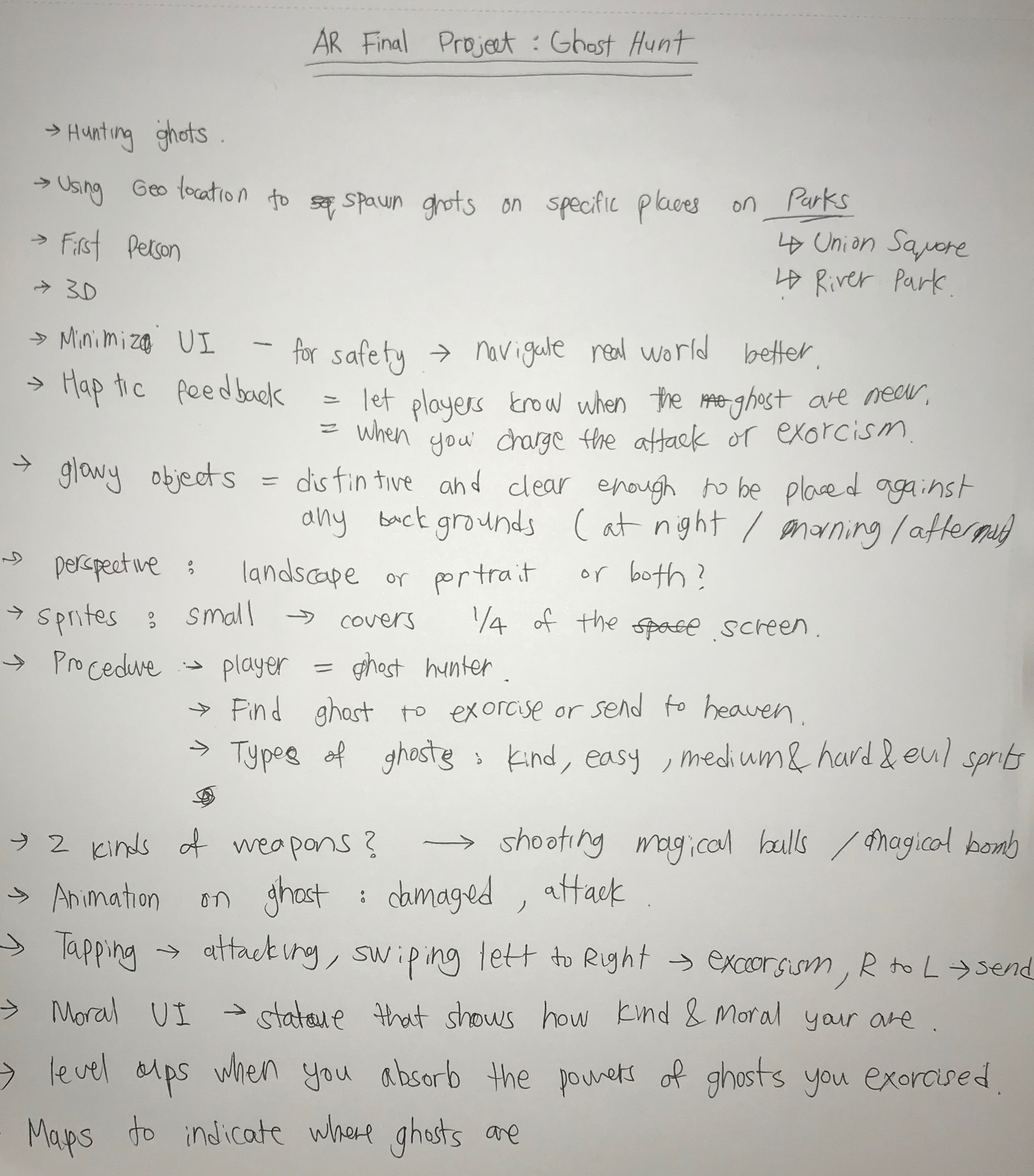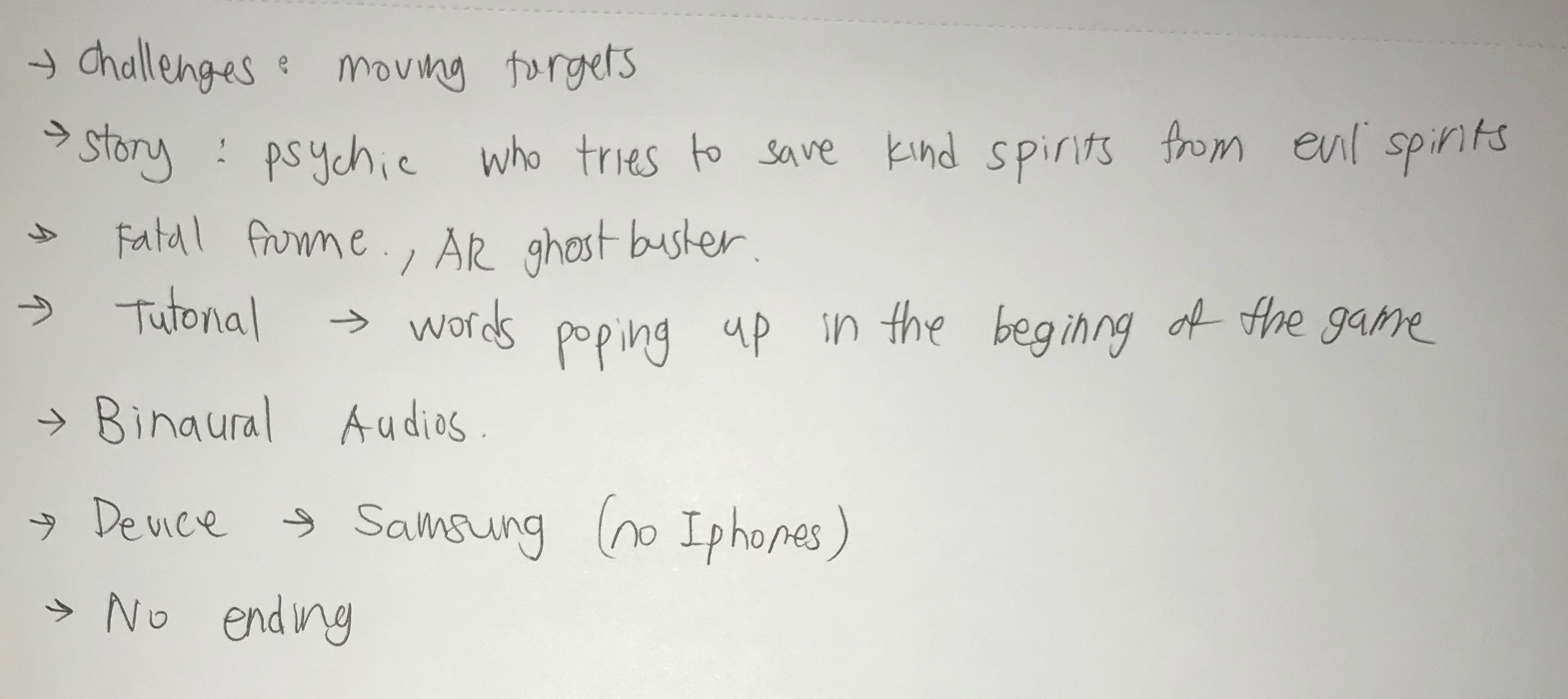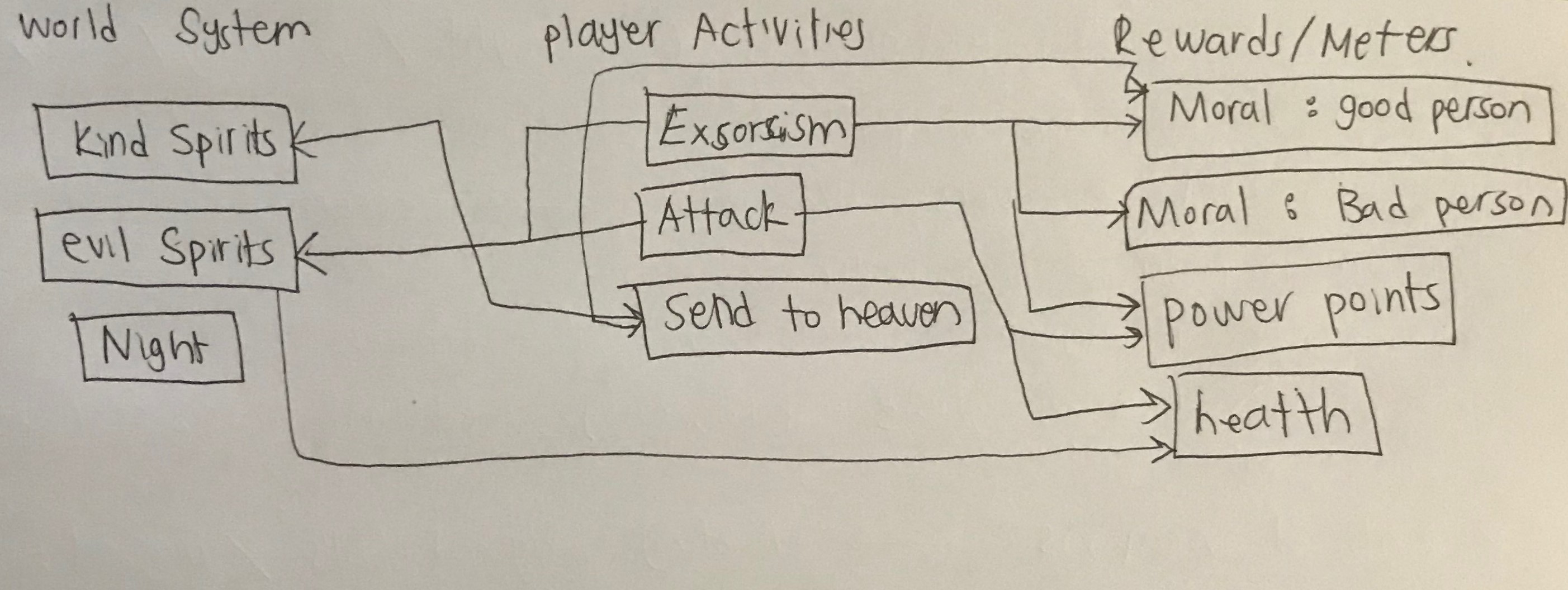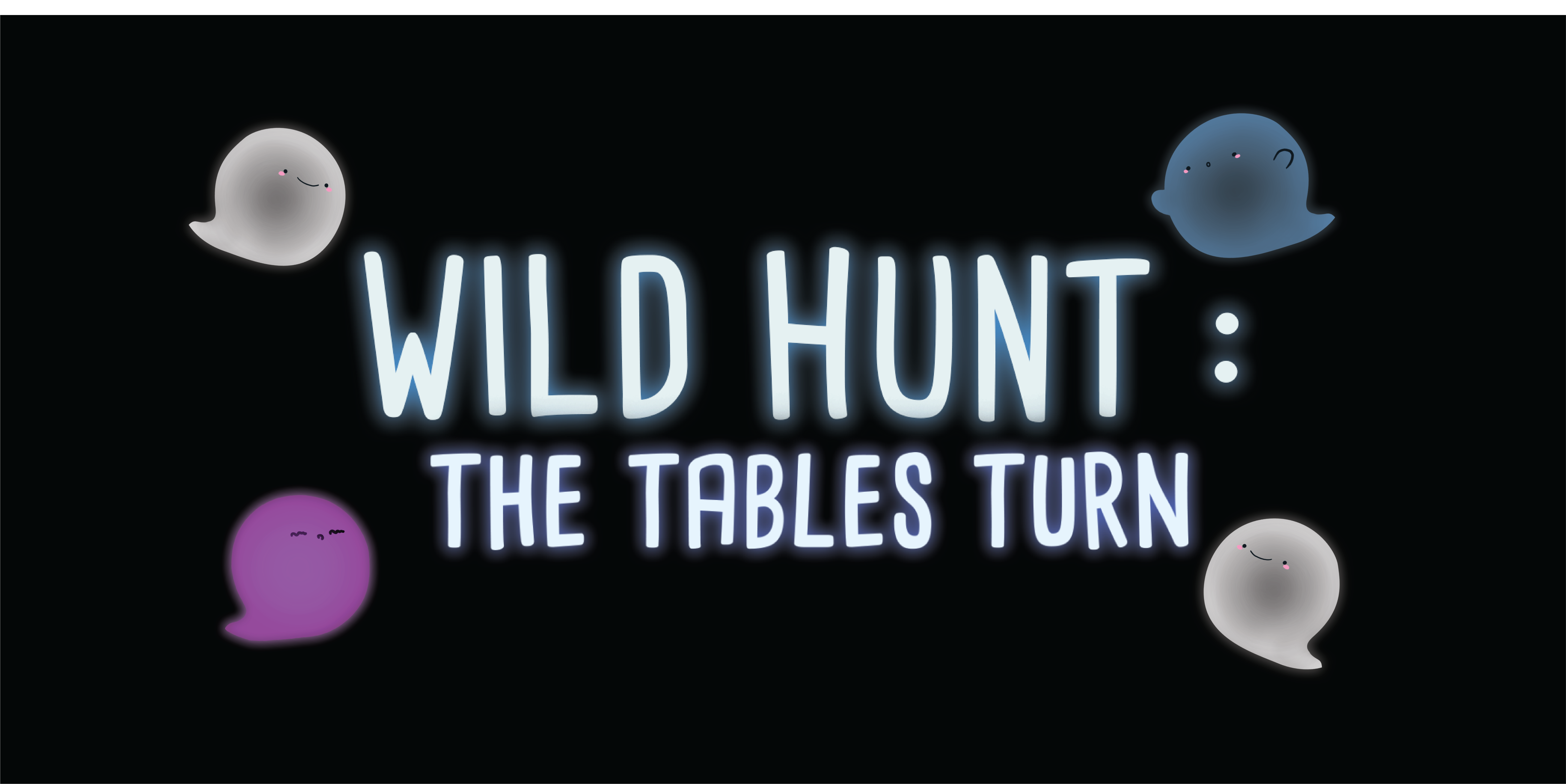GDW: Exercises & Readings & Researchs
Week 11
Exercise :
- 6.7: Describe Your Game (p182)
“AR ghost hunting game about exorcism”
For the last project, our group, Jib, Costas and I are making the AR ghost game. This game is for a single player and can explore and discover different ghosts of kind, easy, medium and hard/evil. When you meet evil ghosts, you can perform exorcism by swiping left to right to absorb the power and attack by touching the screen. As the game progresses, players can level up by absorbing ghosts. Also you can help kind ghost to go to heaven; player will receive ‘good’ statue by this!
- 6.8: Write a Treatment (p184)


- 7.8: Diagramming Core Gameplay 2 (p211)

Reading
- GDW Chapter 4: Working with Dramatic Elements (pages 102—125)
When Fullerton explains about designing the game for spectators, this topic interested me, because YouTube / Twitch / online platforms have growing gameplays viewers, which proves the fact that people are satisfied watching gameplay by others. Especially nowadays gamers in many different platforms around the world earn plenty of money, it became a field of career for talented gamers. Usually competitive games are played by YouTubers but it would interesting to see more minor game plays as well as developer’s daily vlog (I thought it would be interesting to see how and where they get their inspirations).
Generally, I am interested in character design (I pursue character design as one of my careers) and throughout the reading, I realized that cultural cliché creates better understandings of characters, however, it could also become too generic. To balance this out, the protagonist should have a slight background of the cultural cliché but not exposed. Instead, emphasizes the personal charm of the character. Of course, this should be supported by an appealing premise and strong silhouette.
What does characters want / need / hope / fear ?
Fullerton said these are four key questions should be included in the character development/design. I agree that once there are a world setting/system and a character, there should be a goal, rules, and objectives.
Fullerton also mentioned that game designers have to consider one more element, which is a balance between “agency” or “empathy.”
“Agency can be completely utilitarian, or it can include aspects of creativity, role-playing, and identification. Empathy is the potential for players to develop an emotional attachment to the character, to identify with their goals and, consequently, the game objectives.”
- GDW Chapter 6: Conceptualization: Sidebar: Experimental Gameplay by Richard Lemarchand (p171)
Richard Lemarxchand pointed important quantity as an experimental game designer that should discover new with games by creating new mechanics, play patterns or new genres. Also to explore the boundary between games and other elements, such as political issues and etc. I am always interested in the collaboration between other majors at school to see different ideas that could be created. I feel like coming up with random ideas is hard but it would be interesting to get those random words by fashion people, music people, or just people who are not studying at game industries. One last point that is actually the most crucial point is finishing the game. It is hard to finish the game especially if it a long term (you burnt out in the middle of the process). Therefore designers should definitely set up the time schedule and deadlines to exhibit among peers(peer pressure).
Research
- Walden by Tracy Fullerton
Walden by Tracy Fullerton is a first person game that simulates the experience of living alone. This living design is made by Henry David Thoreau at Walden Pond in 1845-47. Players are exposed to footsteps, beauty of nature, writings of unique philosopher and discoveries of concepts. The style of the game is in a realistic 3D environment to create a more realistic experience of the setting. This is innovative and new genre of play, in which reflection and insight play takes an important role in the player experience. In the game, players are tasked to maintain daily work and focus on the deeper meaning behind events. By attending those events, players will gain insight and connection into the natural world that portrays the life at Walden.
WEEK 12
Exercise
- Focus your game. How much can you remove and still maintain the core experience?
We have several core elements: geolocation & spawning ghosts, player attacks, ghost behaviors, kinds of ghosts, heath and powers.
At this point, it would be easier to eliminate some ghosts and geolocations to save time. I realized we were too ambitious while we were brainstorming. As an art director in this project, a monster took me generally 3 to 4 days depending on the complexity. Since our group spends 1 week to figure out the idea and geolocation, I had 4 weeks to complete models on top of other works.
We also decreased enemy behaviors. We first thought to have different mechanics other than shooting at players but we took them out because it became too complicated.
We also simplified the relationship between the ghost and the player. In our game, we only exorcise the ghost but there are any other elements. Which is simple and effective for our game.
Reading
- GDW Chapter 11: Fun and Accessibility (p341—373)
Some decision types are as follows:
- Hollow decision: no real consequences
- Obvious decision: no real decision
- Uninformed decision: an arbitrary choice
- Informed decision: where the player has ample information
- Dramatic decision: taps into a player’s emotional state
- Weighted decision: a balanced decision with consequences on both sides
- Immediate decision: has an immediate impact
- Long-term decision: whose impact will be felt down the road
We do question ourselves what makes it fun but my answer was always, “because it is fun.” I could not define what fun is in the game. Probably interesting premise, amazing visuals, and interesting mechanics could uplift the game but from this reading, I realized choices and decisions are the crucial part to make the game “fun.”
I was mostly interested in Dilemma decisions because both choices are horrible but have to pick the better choice. I do think this choice type will limit the outcomes/ optional strategies as Fullerton said but at least during the process, players will try to trick and read each other's mind.
I am a huge fan of puzzle games and I do agree that puzzles create tension. Puzzles in the environment make the players investigating small details and finding the meaning of objects.
For my third project, I implied puzzle into the game (very slightly) which made the game more interesting. However, it was hard to come up with the puzzle since does not know how to code it
Research
- Cloud by Jenova Chen, Designer Perspective: Jenova Chen (p191)
Cloud is an indie puzzle game developed by Jenova Chen with his team of students. The game starts of the protagonist, a boy, dream of flying while asleep in a hospital bed. This concept is based on Jenova Chen’s childhood of hospitalization for asthma and daydream while alone in his room. The player flies through a dream world and manipulate clouds to solve puzzles. This game is to spark emotions in the player that video game industry usually ignored.
WEEK 13
Exercise
- Video a minimum of 5 users playing your game. Do not answer questions. Let them suffer.
Reading
- Why Should Indie Devs Care About Video Game Usability Testing? (https://blackshellmedia.com/2017/11/22/indie-devs-care-video-game-usability-test...)
First of all this reading surprised me how detailed categories playtesting and pros & cons of each one. I personally like on-site testing because I could check all the reactions of the players.
Through this reading, I also realized that we should set our target audience too. This will change the result.
Class notes:
- Fast feedback, guerilla testing
- Guerilla testing allows for more testers (20+ testers)
- Exposes hidden problems that are invisible to developers
- Validating assumptions about the audience
- Allows for observable behavior
- Does the UI self explain? Ability to track behavior
- no one plays the same. Players will break your game
- Audience questionnaire - data collection and selling your ideas
- Do the rules make sense?
- Learn how the majority play your game - develop mechanics around that
- Do aesthetics resonate with the audience?
- Prioritization of mechanics - focus on what works, drop what doesn’t
- Find new audiences
- How long does a play session last?
Research
- User testing. Document the best practices that makes sense to you. Plan for a structure you can re-use in other semesters and projects.
- First set up the booth before testers arrive. Devices are ready, games are installed, and drives are plugged.
- When testers have arrived, explain the process of testing and ask permission to record the process. I should not explain everything. Let them suffer.
- Help them and answer the questions they ask. (note that many questions mean there are many problems in the game)
- Write down all the reactions and keywords during the playtest.
- Do the survey/ chat after the playtest.
- Thank them and give them your contact info.
WEEK 14
Exercise
- 10.1: Testing for Functionality
Player was able to complete a game without an instruction but it was confusing for her to know when to exorcise the ghost or when she was attacked. In this case, we should organize the game that players do not get attacked by the ghosts from behind and add more visual feedback while exorcism.
Reading
- GDW Chapter 10: Functionality, Completeness and Balance (pages 305—338)
This chapter taught me how to complete a game in a step of foundation, structure, formal details and refinement. Once those are completed, add structure, system, procedure or rules at a time. This could be done by playtesting.
It is funny and ironic how loophole can become a feature. For example in our game, wild hunt: the tables turn, our ghost should be stationary on the place they were spawned but they tempt to fly away and move around. This was a weird bug that we had no idea how to fix but playtesters enjoyed how active ghosts are.
WEEK 15
Reading
- GDW Chapter 16: Selling Yourself and Your Ideas to the Game Industry (p 481—495)
In this chapter, we are educated with most of the information, however, I still feel like I don't play enough games and does not make a network with people in the industry. Even though I visit several conferences, I have a lack of skills to communicate and interact with them. Also, I never tried to sell my games at the conference before. In this case, I would like to bring my project more outside of the class and communicate with various people.
Get Wild Hunt: The Tables Turn
Wild Hunt: The Tables Turn
An AR game for ghost hunters!!
More posts
- Design ProcessDec 13, 2019
- Playtests: Game Club & WondervilleDec 13, 2019
- PostmortemDec 13, 2019

Leave a comment
Log in with itch.io to leave a comment.